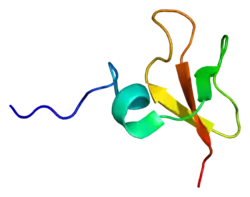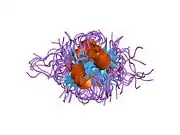DEFB103A
Beta-defensin 103 is a protein that in humans is encoded by the DEFB103A gene.[3][4][5]
Function
Defensins form a family of microbicidal and cytotoxic peptides made by neutrophils. Members of the defensin family are highly similar in protein sequence. This gene encodes defensin, beta 103B, which has broad spectrum antimicrobial activity and may play an important role in innate epithelial defense.[5]
In dogs, the product of the same genetic locus, β-Defensin 103, also plays a role in pigmentation, being an agonist of the melanocortin 1 receptor.[6]
References
- ENSG00000273641 GRCh38: Ensembl release 89: ENSG00000177243, ENSG00000273641 - Ensembl, May 2017
- "Human PubMed Reference:". National Center for Biotechnology Information, U.S. National Library of Medicine.
- Jia HP, Schutte BC, Schudy A, Linzmeier R, Guthmiller JM, Johnson GK, Tack BF, Mitros JP, Rosenthal A, Ganz T, McCray PB Jr (Mar 2001). "Discovery of new human beta-defensins using a genomics-based approach". Gene. 263 (1–2): 211–8. doi:10.1016/S0378-1119(00)00569-2. PMID 11223260.
- Harder J, Bartels J, Christophers E, Schroder JM (Feb 2001). "Isolation and characterization of human beta -defensin-3, a novel human inducible peptide antibiotic". J Biol Chem. 276 (8): 5707–13. doi:10.1074/jbc.M008557200. PMID 11085990.
- "Entrez Gene: DEFB103A defensin, beta 103A".
- Candille SI, Kaelin CB, Cattanach BM, Yu B, Thompson DA, Nix MA, Kerns JA, Schmutz SM, Millhauser GL, Barsh GS (November 2007). "A -defensin mutation causes black coat color in domestic dogs". Science. 318 (5855): 1418–23. doi:10.1126/science.1147880. PMC 2906624. PMID 17947548.
Further reading
- Hartley JL, Temple GF, Brasch MA (2001). "DNA cloning using in vitro site-specific recombination". Genome Res. 10 (11): 1788–95. doi:10.1101/gr.143000. PMC 310948. PMID 11076863.
- Tomita T, Nagase T (2001). "[Defensins as a mechanism of host defense and innate immunity]". Nippon Ronen Igakkai Zasshi. Japanese Journal of Geriatrics. 38 (4): 440–3. doi:10.3143/geriatrics.38.440. PMID 11523142.
- García JR, Jaumann F, Schulz S, et al. (2002). "Identification of a novel, multifunctional beta-defensin (human beta-defensin 3) with specific antimicrobial activity. Its interaction with plasma membranes of Xenopus oocytes and the induction of macrophage chemoattraction". Cell Tissue Res. 306 (2): 257–64. doi:10.1007/s004410100433. PMID 11702237. S2CID 27786343.
- Biragyn A, Surenhu M, Yang D, et al. (2002). "Mediators of innate immunity that target immature, but not mature, dendritic cells induce antitumor immunity when genetically fused with nonimmunogenic tumor antigens". J. Immunol. 167 (11): 6644–53. doi:10.4049/jimmunol.167.11.6644. PMID 11714836.
- Schibli DJ, Hunter HN, Aseyev V, et al. (2002). "The solution structures of the human beta-defensins lead to a better understanding of the potent bactericidal activity of HBD3 against Staphylococcus aureus". J. Biol. Chem. 277 (10): 8279–89. doi:10.1074/jbc.M108830200. PMID 11741980.
- Dunsche A, Açil Y, Dommisch H, et al. (2002). "The novel human beta-defensin-3 is widely expressed in oral tissues". Eur. J. Oral Sci. 110 (2): 121–4. doi:10.1034/j.1600-0722.2002.11186.x. PMID 12013554.
- Paulsen F, Pufe T, Conradi L, et al. (2003). "Antimicrobial peptides are expressed and produced in healthy and inflamed human synovial membranes". J. Pathol. 198 (3): 369–77. doi:10.1002/path.1224. PMID 12375270. S2CID 20348830.
- Strausberg RL, Feingold EA, Grouse LH, et al. (2003). "Generation and initial analysis of more than 15,000 full-length human and mouse cDNA sequences". Proc. Natl. Acad. Sci. U.S.A. 99 (26): 16899–903. doi:10.1073/pnas.242603899. PMC 139241. PMID 12477932.
- Abiko Y, Nishimura M, Kusano K, et al. (2004). "Upregulated expression of human beta defensin-1 and -3 mRNA during differentiation of keratinocyte immortalized cell lines, HaCaT and PHK16-0b". J. Dermatol. Sci. 31 (3): 225–8. doi:10.1016/S0923-1811(03)00007-0. PMID 12727027.
- Nishimura M, Abiko Y, Kusano K, et al. (2003). "Localization of human beta-defensin 3 mRNA in normal oral epithelium, leukoplakia, and lichen planus: an in situ hybridization study". Medical Electron Microscopy. 36 (2): 94–7. doi:10.1007/s00795-002-0206-8. PMID 12825122. S2CID 1543924.
- Wu Z, Hoover DM, Yang D, et al. (2003). "Engineering disulfide bridges to dissect antimicrobial and chemotactic activities of human beta-defensin 3". Proc. Natl. Acad. Sci. U.S.A. 100 (15): 8880–5. doi:10.1073/pnas.1533186100. PMC 166407. PMID 12840147.
- King AE, Fleming DC, Critchley HO, Kelly RW (2004). "Differential expression of the natural antimicrobials, beta-defensins 3 and 4, in human endometrium". J. Reprod. Immunol. 59 (1): 1–16. doi:10.1016/S0165-0378(02)00083-9. PMID 12892899.
- Chadebech P, Goidin D, Jacquet C, et al. (2004). "Use of human reconstructed epidermis to analyze the regulation of beta-defensin hBD-1, hBD-2, and hBD-3 expression in response to LPS". Cell Biol. Toxicol. 19 (5): 313–24. doi:10.1023/B:CBTO.0000004975.36521.c8. PMID 14703118. S2CID 20166061.
- Pernet I, Reymermier C, Guezennec A, et al. (2004). "Calcium triggers beta-defensin (hBD-2 and hBD-3) and chemokine macrophage inflammatory protein-3 alpha (MIP-3alpha/CCL20) expression in monolayers of activated human keratinocytes". Exp. Dermatol. 12 (6): 755–60. doi:10.1111/j.0906-6705.2003.00086.x. PMID 14714554. S2CID 84942825.
- Yoshimoto T, Yamaai T, Mizukawa N, et al. (2004). "Different expression patterns of beta-defensins in human squamous cell carcinomas". Anticancer Res. 23 (6C): 4629–33. PMID 14981906.
- Joly S, Organ CC, Johnson GK, et al. (2005). "Correlation between beta-defensin expression and induction profiles in gingival keratinocytes". Mol. Immunol. 42 (9): 1073–84. doi:10.1016/j.molimm.2004.11.001. PMID 15829297.
- Varoga D, Pufe T, Harder J, et al. (2005). "Human beta-defensin 3 mediates tissue remodeling processes in articular cartilage by increasing levels of metalloproteinases and reducing levels of their endogenous inhibitors". Arthritis Rheum. 52 (6): 1736–45. doi:10.1002/art.21090. PMID 15934078.
- Niyonsaba F, Ushio H, Nagaoka I, et al. (2005). "The human beta-defensins (-1, -2, -3, -4) and cathelicidin LL-37 induce IL-18 secretion through p38 and ERK MAPK activation in primary human keratinocytes". J. Immunol. 175 (3): 1776–84. doi:10.4049/jimmunol.175.3.1776. PMID 16034119.
This article is issued from Wikipedia. The text is licensed under Creative Commons - Attribution - Sharealike. Additional terms may apply for the media files.



